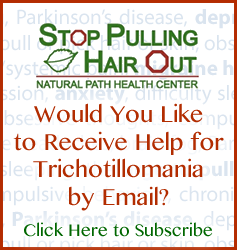 We spend a lot of time on this blog talking about the ins and outs of amino acid therapy as an effective solution to the underlying neurotransmitter imbalance(s) that often lead to trich. However, there is also a behavioral component that cannot be overlooked and must also be addressed. Most people experience both the ‘urge’ to pull and develop a ‘habit’ of pulling.
We spend a lot of time on this blog talking about the ins and outs of amino acid therapy as an effective solution to the underlying neurotransmitter imbalance(s) that often lead to trich. However, there is also a behavioral component that cannot be overlooked and must also be addressed. Most people experience both the ‘urge’ to pull and develop a ‘habit’ of pulling.
For instance, many people pull at certain times of day or under certain situations, such as while driving, while studying or when watching TV. They may not even notice that they are doing it. The key is what happens when they do notice – can they tell themselves to stop and move on without giving it another thought? Or do they then have to constantly think about it in an internal struggle not to begin pulling again?
When the underlying neurotransmitter imbalances have been addressed, the urge to pull disappears. However, the habit remains. The good news is that once the urge is gone, when a person catches themselves pulling, they can take a look at the situation and make a decision to stop pulling – and then let it go. Because the urge is gone, they no longer need to bother with any thought of pulling. If they catch themselves pulling again out of habit, they simply correct the behavior. This is in stark contrast to someone that has to continually battle with themselves to not pull their hair out.
Once the urge is gone, behavior modification therapies often are an incredible help. These can be as simple as sitting on ones hands or keeping the hands busy to help break those habitual patterns, or involve more in-depth therapy, such as cognitive behavior therapy (CBT). Many of our clients who had tried CBT in the past with little success report outstanding results once their neurotransmitter levels are balanced.
Differentiating between the urge and habit is important. Habits can be changed with time and attention. Urges require that the underlying biochemical imbalance be corrected.
To find a Cognitive Behavioral Therapist, visit the National Association of Cognitive-Behavioral Therapists website or the Trichotillomania Learning Centers Resource page.

